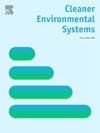An economic and environmental assessment of different bus powertrain technologies in public transportation
IF 4.9
Q2 ENGINEERING, ENVIRONMENTAL
引用次数: 0
Abstract
Hydrogen and electric buses are considered effective options for decarbonizing the public transportation sector, positioning them as a leader in this transition. This study models the environmental and economic performances of a set of bus powertrain technologies, considering a real case-study of suburban public transport in Italy, and including fuel cell electric vehicles (FCEV), battery electric vehicles (BEV), biomethane-powered vehicles (CBM), natural gas (CNG), and diesel buses. The environmental performances of FCEV and BEV are significantly influenced by the energy source used for hydrogen production or battery charging. Specifically, using the electricity mix for FCEV leads to the highest greenhouse gas emissions and fossil fuel demand. In contrast, BEV show better environmental performance than conventional powertrains, especially when powered by photovoltaics. When powered by photovoltaics, BEV reveal similar results to FCEV in terms of environmental impacts, except for resource depletion, where both perform poorly. Transitioning from diesel to BEV or FCEV can enhance local air quality, regardless of the energy source. The economic analysis indicates that FCEV are the most expensive option, followed by BEV, both of which are currently costlier than diesel and CNG systems. CBM from waste streams emerges as a cost-effective and environmentally friendly solution. This study suggests prioritizing biomethane derived from biowaste, manure, and residual biomass (excluding energy crops) as a part of the fuels for public transport decarbonization in the EU to advance EU decarbonization goals, despite limitations due to resource availability. Furthermore, BEV powered by renewables should be prioritized whenever their range is adequate.∗
公共交通中不同的公共汽车动力系统技术的经济和环境评估
氢燃料和电动公交车被认为是公共交通部门脱碳的有效选择,将它们定位为这一转型的领导者。本研究以意大利郊区公共交通为例,模拟了一系列公共汽车动力总成技术的环境和经济性能,包括燃料电池电动汽车(FCEV)、电池电动汽车(BEV)、生物甲烷动力汽车(CBM)、天然气(CNG)和柴油公交车。氢燃料电池汽车和纯电动汽车的环境性能受到制氢能源或电池充电能源的显著影响。具体来说,将混合电力用于FCEV会导致最高的温室气体排放和化石燃料需求。相比之下,纯电动汽车表现出比传统动力系统更好的环保性能,特别是当由光伏发电供电时。当由光伏供电时,BEV在环境影响方面显示出与FCEV相似的结果,除了资源消耗,两者都表现不佳。无论能源来源如何,从柴油转向BEV或FCEV都可以改善当地的空气质量。经济分析表明,燃料电池汽车是最昂贵的选择,其次是纯电动汽车,两者目前都比柴油和压缩天然气系统贵。从废物流中提取煤层气是一种具有成本效益和环境友好的解决方案。本研究建议优先考虑从生物废物、粪便和剩余生物质(不包括能源作物)中提取的生物甲烷,作为欧盟公共交通脱碳燃料的一部分,以推进欧盟的脱碳目标,尽管由于资源可用性的限制。此外,只要可再生能源驱动的纯电动汽车的行驶里程足够,就应优先考虑
本文章由计算机程序翻译,如有差异,请以英文原文为准。
求助全文
约1分钟内获得全文
求助全文
来源期刊

Cleaner Environmental Systems
Environmental Science-Environmental Science (miscellaneous)
CiteScore
7.80
自引率
0.00%
发文量
32
审稿时长
52 days
 求助内容:
求助内容: 应助结果提醒方式:
应助结果提醒方式:


